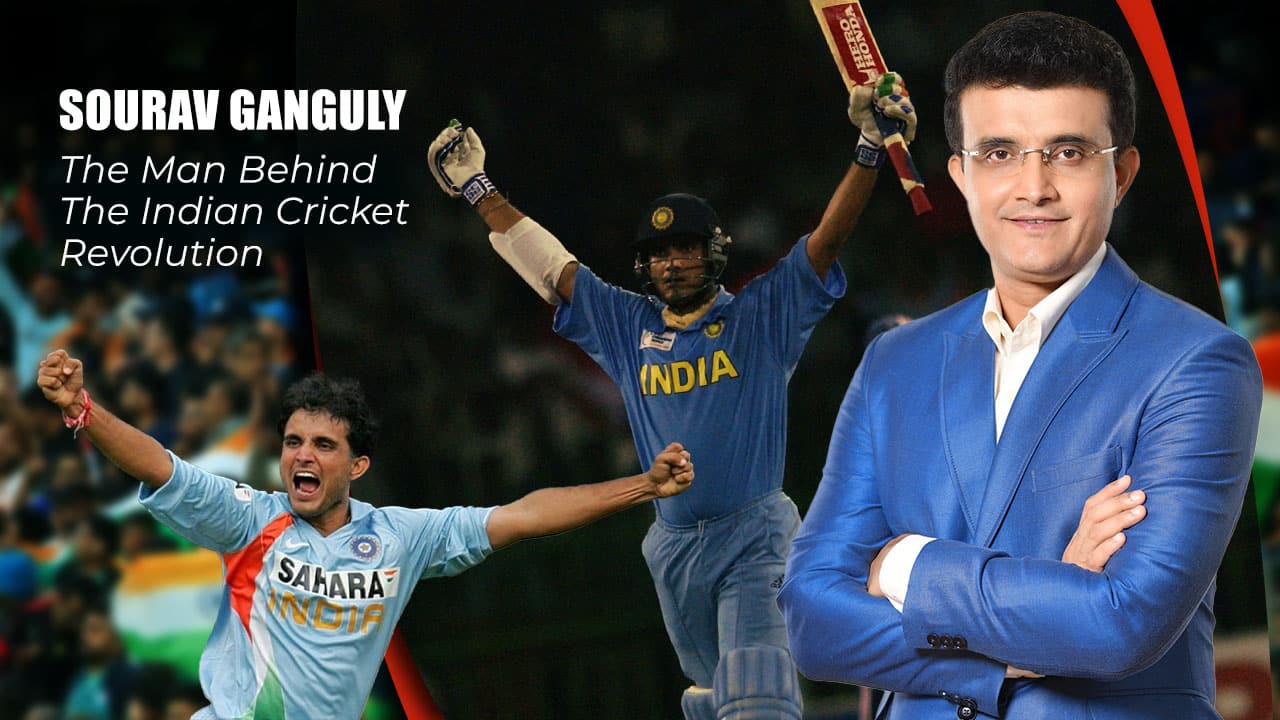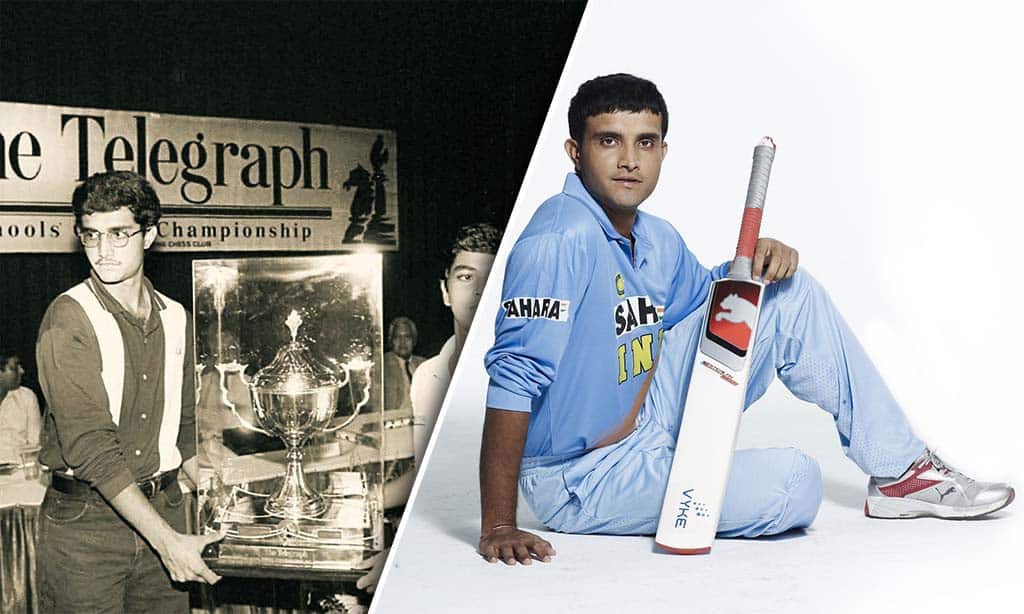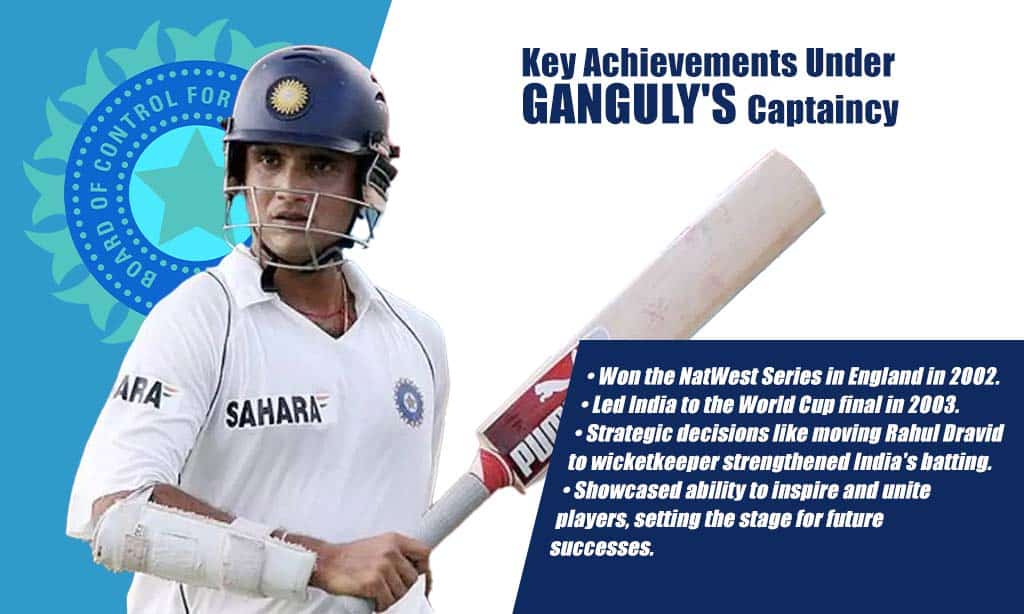Indian cricket fans often wonder about the origins of their team’s aggressive style. Many don’t know the key figure behind this shift. Sourav Ganguly changed Indian cricket forever. Today July 8, 2024 is his 52nd birthday. Happy birthday Sourav Ganguly Dada!
Ganguly took charge as captain after a match-fixing scandal rocked Indian cricket in 2000. He led India to several big wins, including reaching the 2003 World Cup final. This blog post will explain how Sourav Ganguly transformed Indian cricket.
Get ready to learn about the man who made India a cricket powerhouse.
Sourav Ganguly: Early Life and Entry into Cricket
Sourav Ganguly’s cricket journey began in the streets of Kolkata. He honed his skills at Behala’s Paikpara Cricket Club, catching the eye of local coaches with his natural talent.
| Full Name | Sourav Chandidas Ganguly |
| Nickname | Dada, Prince of Calcutta, God of the Off Side |
| Date of Birth | July 8, 1972 |
| Place of Birth | Calcutta (now Kolkata), West Bengal, India |
| Batting Style | Left-handed |
| Bowling Style | Right-arm medium |
| Height | 5 ft 11 in (1.80 m) |
| Role | Batsman, Left-arm medium bowler |
| International Debut |
|
| Last International Match |
|
| Test Career |
|
| ODI Career |
|
| Captaincy |
|
| Major Achievements |
|
| Domestic Teams | Bengal, Lancashire, Glamorgan, Northamptonshire |
| IPL Teams | Kolkata Knight Riders (2008-2010), Pune Warriors India (2011-2012) |
| Post-Playing Career |
|
| Notable Records |
|
| Personal Life |
|
| Education | St. Xavier’s College, Kolkata |
| Autobiography | “A Century is Not Enough” (2018) |
| Awards | Padma Shri (2004), Banga Bibhushan (2013) |
Early years and initial influences
Sourav Ganguly’s cricket journey began in Kolkata, India. Born into a cricket-loving family, he picked up the bat at age 3. His elder brother Snehasish Ganguly, a first-class cricketer, played a crucial role in shaping young Sourav’s skills.
Ganguly’s talent shone early at St. Xavier’s School, where he captained the cricket team. He honed his left-handed batting style and off-spin bowling at local clubs. At 18, he made his first-class debut for Bengal in the 1989-90 Ranji Trophy, scoring a century against Odisha.
This performance caught selectors’ eyes, setting the stage for his future ascent in Indian cricket.
Breakthrough in domestic cricket
Ganguly’s domestic cricket breakthrough came in 1989-90. He scored 442 runs in the Ranji Trophy, catching selectors’ eyes. His aggressive batting style and left-handed technique stood out.
In 1990, he made his first-class debut for Bengal against Odisha.
Ganguly’s performances in domestic circuits skyrocketed. He notched up impressive scores in Duleep Trophy and Deodhar Trophy. His consistent run-making ability and leadership potential became evident.
These domestic successes paved the way for his international career, culminating in his Test debut in 1996.
Sourav Ganguly: Ascension to Indian Team Captaincy
Sourav Ganguly took charge of the Indian cricket team in 2000. He faced early challenges but quickly turned things around with his bold leadership style.
#HappyBirthdayDada
The Great Kapil Dev Sir about our @SGanguly99 Dada’s Leadership .!!#HappybirthdayDada #WELOVEYOUDADA #ThankYouDada #GanguliansFestival #SouravGanguly #Ganguly #Dada #July8th #KapilDev #DadaForever #HappyBirthdaDada pic.twitter.com/XqTY93OSBF— Pambi Praveen Kumar #HappyBirthdayDADA🎉 (@PraveenPGanguly) July 7, 2024
Challenges and early setbacks
Ganguly faced intense scrutiny upon becoming captain in 2000. The match-fixing scandal had shaken Indian cricket’s foundation. He inherited a team low on morale and public trust. Critics questioned his leadership abilities and batting form.
Early losses against Australia and South Africa fueled doubts.
Ganguly’s aggressive style clashed with traditionalists. He battled conservative selectors over team composition. The media criticized his on-field demeanor and off-field decisions.
Despite setbacks, Ganguly persevered. He focused on building a cohesive unit and instilling self-belief in young players like Yuvraj Singh, Mohammad Kaif, Harbhajan Singh and Zaheer Khan.
Strategies for team building and leadership
Ganguly’s leadership style focused on building a cohesive unit. He identified and nurtured young talents like Yuvraj Singh, Mohammad Kaif, Harbhajan Singh, Zaheer Khan, and MS Dhoni. His approach emphasized aggression on the field and instilled a never-say-die attitude among players.
This shift in mindset helped transform India into a formidable force in world cricket.
Team selection under Ganguly prioritized fitness and performance. He removed unfit players and gave opportunities to those who showed promise. His strategies included backing players through tough times, promoting healthy competition within the team, and fostering a sense of belonging.
These tactics helped create a strong team culture that laid the foundation for India’s future successes.
Key Achievements Under Sourav Ganguly’s Captaincy
Ganguly’s captaincy brought India cricket glory. His team won the NatWest Series in England and reached the World Cup final in 2003.
2002 NatWest Series victory
The 2002 NatWest Series final marked a turning point for Indian cricket. India chased down England’s mammoth 325-run target at Lord’s, sparked by Mohammad Kaif and Yuvraj Singh’s heroics.
Ganguly’s iconic shirt-waving celebration on the Lord’s balcony became a symbol of India’s new aggressive approach.
[Video credit @officialenglandcricket]
This victory changed India’s mindset in limited-overs cricket. It instilled belief in the team’s ability to win abroad and chase big totals. The triumph laid the foundation for future successes, including reaching the 2003 World Cup final.
It also cemented Ganguly’s reputation as a bold leader who inspired his team to punch above their weight.
2003 World Cup finals appearance
India’s journey to the 2003 World Cup finals was nothing short of remarkable. Ganguly’s leadership propelled the team through tough matches against England, Pakistan, and Kenya. In the final, they faced a formidable Australian side led by Ricky Ponting.
Despite a valiant effort, India fell short, but their performance sparked a new era of confidence in Indian cricket.
Ganguly’s strategic decisions during the tournament proved crucial. He moved Rahul Dravid to wicketkeeper, allowing for an extra batsman in the lineup. This bold move paid off, strengthening India’s batting depth and flexibility.
The team’s run to the finals showcased Ganguly’s ability to inspire and unite players, setting the stage for future successes in Indian cricket.
Impact on Team Culture and International Perception
Ganguly brought a new fire to Indian cricket. He pushed his team to be bold and assertive on the field, changing how others saw them.
Emphasis on aggression and self-belief
Sourav Ganguly revolutionized Indian cricket with his aggressive leadership style. He instilled a “never-say-die” attitude in the team, pushing players to fight hard on the field. This approach transformed India’s reputation from “nice guys” to fierce competitors.
Ganguly’s emphasis on self-belief empowered young talents like Yuvraj Singh and MS Dhoni. He backed players with potential, giving them confidence to perform at the highest level. Former England captain Nasser Hussain praised Ganguly’s combative qualities, noting how they shaped India’s new cricket identity.
Nurturing of young talents like Yuvraj and Dhoni
Ganguly’s captaincy marked a golden era for nurturing young talent in Indian cricket. He introduced and backed players like Yuvraj Singh and MS Dhoni, who later became cricket legends.
Ganguly’s faith in these rookies paid off – Yuvraj’s explosive batting and Dhoni’s innovative wicket-keeping transformed India’s middle order. Their success under Ganguly’s leadership laid the foundation for India’s future triumphs, including the 2007 T20 World Cup and 2011 ODI World Cup victories.
Ganguly’s eye for talent didn’t stop there. He also gave opportunities to Zaheer Khan, Harbhajan Singh, and Gautam Gambhir – all crucial players in India’s rise to cricket supremacy.
His knack for spotting potential and providing a platform for youngsters to shine reshaped India’s cricket landscape. This emphasis on youth development became a cornerstone of Indian cricket strategy, continuing long after Ganguly’s captaincy ended.
Sourav Ganguly: Controversies and Challenges
Ganguly’s tenure wasn’t without its rough patches. His clash with coach Greg Chappell sparked heated debates in cricket circles. This, coupled with power struggles in the cricket board, tested Ganguly’s leadership mettle.
Rift with coach Greg Chappell
Greg Chappell’s tenure as India’s coach sparked controversy. His relationship with Ganguly deteriorated rapidly. Chappell questioned Ganguly’s leadership and batting form. The coach allegedly asked Ganguly to step down as captain before a Zimbabwe tour.
This led to a public spat between the two cricket figures.
The Board of Control for Cricket in India (BCCI) intervened in the conflict. They temporarily dropped Ganguly from the team. The rift divided Indian cricket fans and media. It highlighted issues in team management and selection processes.
Ganguly made a comeback, proving his resilience and batting skills.
Issues within the cricket administration
Ganguly’s tenure as BCCI president faced significant challenges. He clashed with other board members over team selection policies and coaching appointments. The board’s resistance to implementing Ganguly’s vision for domestic cricket improvements created friction.
Conflicts arose regarding the distribution of funds to state cricket associations. Ganguly pushed for more transparency in financial matters, meeting opposition from entrenched interests.
Power struggles within the BCCI hindered Ganguly’s reform efforts. He advocated for changes to the IPL format and revenue sharing model, sparking debates. Disagreements over broadcasting rights deals and sponsorship agreements added to administrative tensions.
Ganguly’s attempts to modernize cricket governance faced pushback from traditional factions in Indian cricket’s power structure.
Sourav Ganguly: Legacy and Influence on Indian Cricket
Ganguly changed how India picked players and ran its cricket team. His bold style made Indian players more confident on the world stage.
Changes in team selection and management
Ganguly revolutionized team selection during his captaincy. He focused on nurturing young talent, giving chances to players like Yuvraj Singh and MS Dhoni. This shift prioritized potential over experience, creating a more dynamic team composition.
His management style emphasized aggression and self-belief. Ganguly empowered his teammates, fostering leadership qualities within the squad. This approach transformed India’s cricket culture, instilling confidence to compete fiercely on the global stage.
Lasting impact on player attitudes and national expectations
Ganguly’s leadership transformed Indian cricket’s mindset. Players developed a winning attitude, shedding their underdog mentality. The team began to believe in their ability to compete against top sides, especially overseas.
This shift in confidence rippled through generations of cricketers.
Fans’ expectations soared as India became a force to reckon with. No longer satisfied with occasional wins, supporters demanded consistent performances. The nation’s cricket aspirations grew, fueling a hunger for success that persists today.
This cultural change laid the foundation for India’s current status as a cricketing powerhouse.
Sourav Ganguly: Post-Retirement Contributions
Ganguly took on new roles after hanging up his bat. He joined cricket’s top brass and pushed for better fields and training spots back home.
Role in cricket administration
Ganguly’s impact on cricket extends beyond the field. He became president of the Board of Control for Cricket in India (BCCI) in 2019. His tenure saw the introduction of day-night Test matches in India, boosting attendance and viewer engagement.
He pushed for more transparency in BCCI operations and focused on improving domestic cricket infrastructure.
As BCCI chief, Ganguly advocated for increased player salaries and better facilities at smaller cricket centers. He oversaw the successful completion of the Indian Premier League during the COVID-19 pandemic, ensuring its financial stability.
He appointed Rohit Sharma as the Indian male cricket team captain which earned the nation a ICC world event trophy after 11 years of drought. India won the ICC T20 World Cup 2024 under Rohit’s captaincy.
His administrative skills also led to his appointment as chair of the ICC Men’s Cricket Committee in 2021, influencing global cricket policies.
Efforts in improving domestic cricket infrastructure
Ganguly spearheaded major upgrades to India’s domestic cricket scene. He pushed for better pitches, improved training facilities, and more competitive tournaments. The Ranji Trophy saw a revamp under his watch, with new teams added and a focus on developing talent from smaller cities.
Stadiums across India got facelifts, with modern amenities and world-class playing surfaces. Ganguly introduced day-night matches in domestic cricket, preparing players for international formats.
His efforts laid the groundwork for India’s future cricket success, creating a robust pipeline of skilled players ready for the global stage.
Sourav Ganguly: Takeaways
Sourav Ganguly’s impact on Indian cricket transcends his playing career. His bold leadership style changed the team’s mindset and global perception. He nurtured young talents like Yuvraj Singh and MS Dhoni, shaping the future of Indian cricket.
Ganguly’s legacy continues through his work in cricket administration and efforts to improve domestic infrastructure. His vision and determination paved the way for India’s rise as a cricketing powerhouse.










































